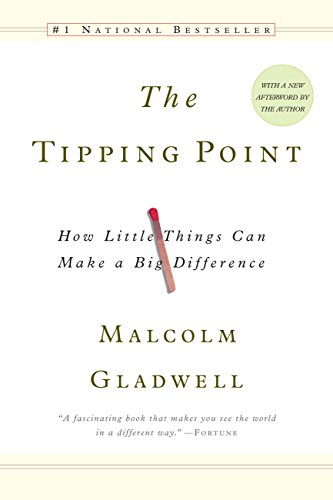

This article is an excerpt from the Shortform summary of "The Tipping Point" by Malcolm Gladwell. Shortform has the world's best summaries of books you should be reading.
Like this article? Sign up for a free trial here .
In The Tipping Point, Malcolm Gladwell explains how social epidemics — spreading ideas, messages, behaviors, and products — function like viruses, growing gradually until they reach a critical mass (the tipping point) and explode. What are some good tipping-point examples?
We’ll look at two powerful tipping-point examples from Gladwell’s book and discuss how epidemics occur in both the medical and social worlds.
What Is the Tipping Point?
Before we look at our tipping point examples, we need to know what the tipping point is. It’s based on the idea of medical epidemics.
Epidemics don’t build gradually and steadily; they grow and reach a boiling point or critical mass, at which point they explode and turn into an epidemic. That threshold is called the tipping point.
It can be hard to wrap our head around the notion that drastic change happens at one particular point because we tend to think that significant changes occur in a steady progression (e.g. a river doesn’t flood instantaneously when a storm hits; the water steadily rises over hours of heavy rain). But the tipping point is a critical moment when minor change makes all the difference (e.g. the moment the water crests the river bank).
Think of snow: The difference between 34 and 31 degrees Fahrenheit doesn’t feel much colder than the difference between 37 and 34 degrees. But when that same three-degree drop happens at the tipping point — 32 degrees — rain becomes snow.
Principles of the Tipping Point Examples
As we’ll see, our tipping point examples exemplify three principles of the tipping point.
This book focuses on how to push ideas or products to a tipping point in order to create a social epidemic. There are three factors that can be adjusted to tip an idea to a social epidemic: the messenger, the message itself, or the context of the message. You can turn your ordinary idea into an epidemic by altering one or more of these aspects.
- The Law of the Few: Certain types of people are especially effective at spreading an infectious idea, product, or behavior.
- The Stickiness Factor: You can change the presentation of a message to make it more contagious and stickier (having a more lasting impact).
- The Power of Context: The environment in which the message or idea is delivered can have a huge impact on whether enough people adopt and spread it to create an epidemic.
Tipping Point Example #1: Baltimore’s Syphilis Epidemic
Let’s take a look at our first tipping point example: In the mid-1990s, a syphilis epidemic exploded in Baltimore. The disease had been present in the city previously, but the confluence of a few, relatively minor factors created a tipping point; all three rules of epidemics were at work.
The Law of the Few
A disproportionately large number of people who were likely to be exposed to the disease were concentrated in two housing projects that bordered the epicenter of the city’s syphilis problem. These two housing projects were demolished around the same time, displacing many infected people to other areas of the city. This spread the disease more widely to other communities, rather than keeping it relatively contained in one or two areas of the city.
The Stickiness Factor
Medical services in the city’s poorest areas took a budgetary hit, cutting the capacity to serve patients in STD clinics. As a result, patients with syphilis had to wait an additional few weeks before getting treatment, in the meantime infecting more people and effectively making the disease more contagious.
The Power of Context
A rise in crack cocaine drew people to poor neighborhoods to buy drugs, increasing the risk of more people getting infected and bringing the disease back into their own neighborhoods. Crack use and addiction also tends to lead to risky sexual behavior, which exacerbates the spread of STDs.
This tipping point example shows how all three principles work together to create an epidemic.
Tipping Point Example #2: The Resurgence of Hush Puppies
You don’t necessarily need all three principles to tip an epidemic — you just need the right ones. In this tipping point example, the Law of the Few and the Power of Context were both pivotal in launching a sneaker brand called Hush Puppies from the brink of decline to epidemic popularity within the span of a few years.
In the early 1990s, Hush Puppies were selling only about 30,000 pairs a year. Around that time, teens in New York City’s SoHo and the East Village began wearing the sneaker specifically because they were not in style. Fashion Mavens likely contributed to the spread of Hush Puppies in these neighborhoods, noticing the ironically un-trendy trend and alerting friends.
Two fashion designers then noticed the budding trend among those New York City teens, and were inspired to use Hush Puppies to complement their couture. The well-known designers acted as Connectors, broadcasting images of the shoes to a massive audience and tipping the epidemic. What’s more, the fact that they noticed the trend in SoHo and the East Village — two neighborhoods known as centers of cutting-edge, fashion-forward, and experimental styles — illustrates the Power of Context; the effect likely would have been different if the story started with a bunch of Kansas City teenagers wearing the sneaker.
Soon celebrities were wearing the sneaker and Hush Puppies became a mainstream trend. Celebrities and other fashion influencers were Salesmen to the public masses who, just a few years earlier, probably wouldn’t have considered buying un-stylish Hush Puppies. With this potent mix of Mavens, Connectors, and Salesmen, the company sold 430,000 pairs in 1995. Sales quadrupled in 1996, and increased again the following year, making this an excellent tipping point example.
Tipping Point Example #3: Adolescent Isolation and School Shootings
The school shooting epidemic in the U.S. since Columbine resulted, at least in part, from adolescent isolation and the construction of exclusively teen-inhabited worlds. Nearly all school shooters have been teens or young adults, so the epidemic spread almost solely among adolescents. Many of the shooters had commonalities, such as being bullied and lonely. But generations of teens have been bullied and lonely before they began shooting up schools.
In this epidemic, Columbine changed something within adolescents’ isolated world to alter the thought processes and behavior of subsequent school shooters. Columbine was the tipping point. Somewhat similarly to the Micronesia’s suicide epidemic, school shootings became a new reaction to an old stimulus (bullying and ostracization), and this response became ritualized and contagious. The epidemic was able to spread because it was safely within the insulated adolescent worlds.
———End of Preview———

Like what you just read? Read the rest of the world's best summary of "The Tipping Point" at Shortform . Learn the book's critical concepts in 20 minutes or less .
Here's what you'll find in our full Tipping Point summary :
- What makes some movements tip into social epidemics
- The 3 key types of people you need on your side
- How to cause tipping points in business and life






